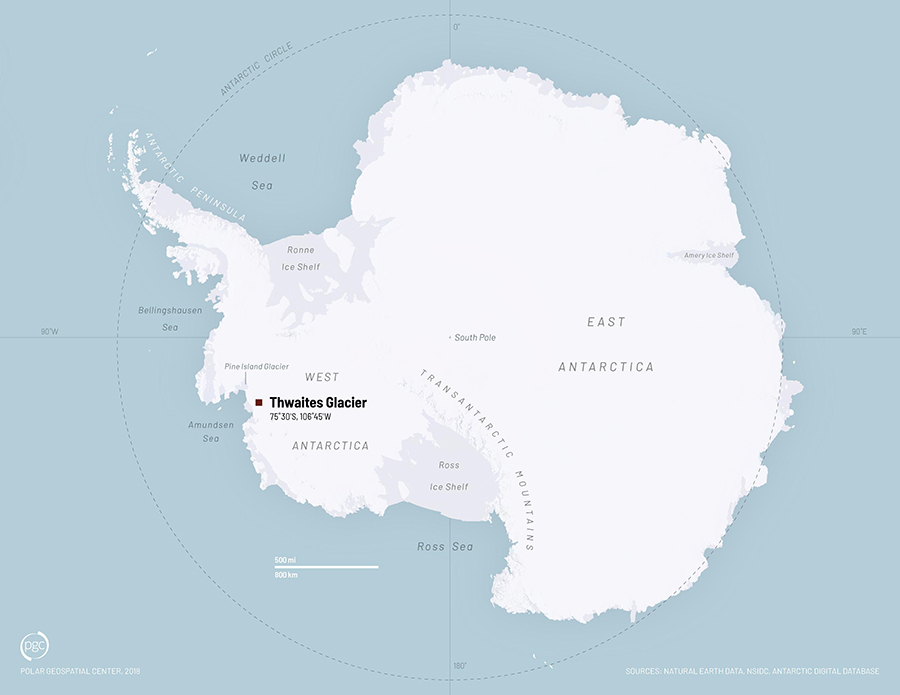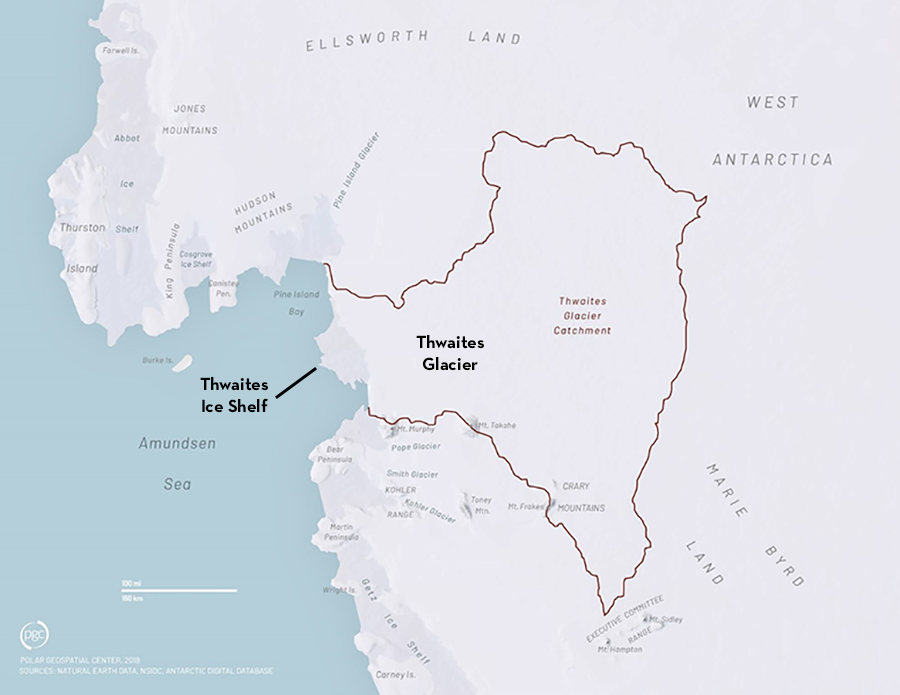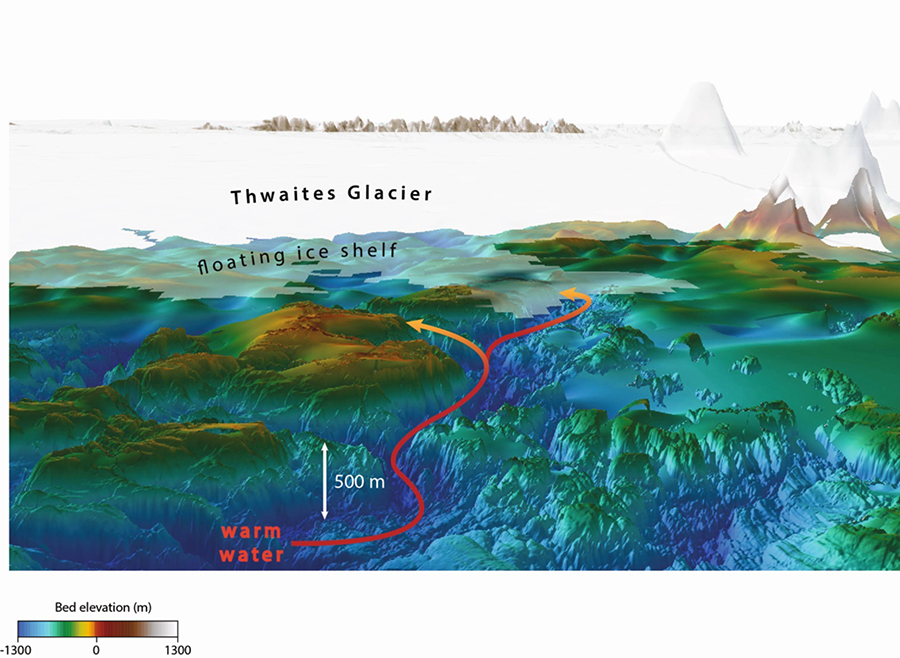Warm ocean water is eroding Thwaites Ice Shelf from belowA first peek from the ocean below shows water eating away at the ice shelf’s critical anchor pointsPosted August 09, 2021
Scientists got their first glimpse at the ocean conditions surrounding the Thwaites Ice Shelf in 2019, and recently published results are worrisome for the rapidly melting ice shelf and the glacier behind it. 
Photo Credit: Polar Geospatial Center
A map showing the location of Thwaites Glacier in West Antarctica.
The first foray of an underwater vehicle beneath the ice shelf found there are three bedrock channels funneling warm water from the open ocean toward the ice. That warm water is melting the ice shelf at an alarming rate. Researchers who analyzed the data estimate there is enough heat flowing through just one of those channels to melt 85 gigatons of ice per year – enough water to fill about 36,000 Great Pyramids of Giza. “Warm water is reaching the underside of the ice and melting it rapidly as it goes afloat,” said Ted Scambos, a polar scientist at the University of Colorado Boulder and U.S. lead of the International Thwaites Glacier Collaboration’s Science Coordination Office. “The remaining ice shelf… looks like it won't survive for more than another 10 years or so. Loss of the ice shelf, and more melt from ocean water, will cause Thwaites glacier to accelerate even more.” “It sort of dawned on us slowly as we worked with the data… that the heat flow was really larger than we expected,” said Anna Wåhlin, an oceanographer at the University of Gothenburg in Sweden and lead author of a recent study detailing the results. What’s more, the results show warm water is hitting critical points anchoring the glacier to the seafloor. The researchers can’t say for sure whether what was observed in 2019 was an outlier, but if those ocean conditions persist, the ice shelf is in serious jeopardy. “We think that means this probably is not sustainable,” Wåhlin said. Ocean and iceThwaites is a Florida-sized glacier on the coast of West Antarctica that is melting rapidly due to climate change. Scientists have been studying it closely for decades because it’s large, melting quickly, and helps stabilize the entire West Antarctic Ice Sheet. 
Photo Credit: Polar Geospatial Center
The Thwaites Glacier is a vast expanse of ice in West Antarctica, covering an area about the size of Florida. Its ice shelf floats atop the Amundsen Sea like a floating dock.
A portion of the glacier extends out into the ocean as an ice shelf. This ice shelf sits atop the Amundsen Sea like a floating dock attached to a shoreline. The ice shelf is an important part of the glacier because it acts like a buttress to the land-based ice behind it and keeps that grounded ice from flowing more quickly into the ocean. Scientists studying Thwaites for the past several decades have found the glacier is melting swiftly and its ice shelf is likewise crumbling: the ice is getting thinner and its front is retreating closer to shore. Most of the ice shelf floats on seawater, but in certain spots, underwater plateaus rise high enough for the ice to touch the seafloor. These pinning points, as scientists call them, are like the legs that support a table: they’re crucial for stabilizing the ice shelf and the glacier behind it. In 2017, the United States and the United Kingdom launched a joint venture to study Thwaites Glacier’s retreat and its potential impact on sea levels in detail. The International Thwaites Glacier Collaboration consists of multiple field projects to study the glacier from land, sea, and air and develop an integrated understanding of what is happening and what could happen in the next decades. Wåhlin, along with colleagues from the U.S. and U.K., is part of a team studying the ocean conditions surrounding the ice shelf. The team set out on a cruise on the U.S. research vessel Nathaniel B. Palmer in February 2019. It’s difficult to get close to Thwaites by ship, as the ocean surrounding the ice shelf is normally blocked with sea ice. But weather and ocean conditions were unusual that year. The sea was abnormally free of ice, and the ship was able to get within a few hundred meters of the ice shelf front – closer than any ship had gone before. The researchers weren’t planning on getting that close to Thwaites, but with the fortuitous conditions, they decided to change their plans. “It really was an unusual opportunity,” said Robert Larter, a marine geophysicist at the British Antarctic Survey and co-author of the new study. “I don't think I’d ever seen a satellite image with open water directly in front of Thwaites like that before.” Warm water everywhereThe researchers decided to take advantage of the opportunity and sent an autonomous underwater vehicle, or AUV, to study the ocean conditions under the ice shelf for the first time. Climate change has pushed warm water from the middle depths of the ocean up onto the continental shelf surrounding Antarctica, but scientists didn’t know much about how close this warm water is getting to Thwaites, what pathways it takes to reach the glacier, or how much ice is melting as a result. 
Photo Credit: International Thwaites Glacier Collaboration
This graphic shows the various weather and ocean processes acting upon Thwaites Glacier and its ice shelf.
The submersible robot swam underneath the ice and through two troughs carved into the seafloor near the ice shelf front. The AUV mapped the seafloor in detail and measured water temperature, salinity, and oxygen levels along the way. The robot’s foray found warm ocean water is reaching the underside of Thwaites Ice Shelf through three access points: those two troughs it swam through and another channel leading to Pine Island Bay. Finding the third access point from Pine Island Bay surprised Wåhlin and her colleagues. They had previously suspected a submarine ridge would block any water from Pine Island Bay from reaching the far side of the ice shelf, but the new results show that isn’t the case. The researchers calculate that there is enough heat flowing through just one of those channels to melt 85 gigatons of ice every year, a close equivalent to the amount of ice the entire ice shelf lost each year from 2010 to 2018. Not only is the warm water carrying a significant amount of heat, it’s also eroding those crucial points where the ice shelf meets the seafloor, according to the study. If those points of contact disappear, the entire ice shelf could break free, leaving the grounded ice behind it free to flow more rapidly into the ocean and accelerate sea level rise. A glacier in perilThe findings add to the growing body of evidence that the ice shelf is quickly disintegrating, but the researchers are hesitant to draw conclusions with only one year of data. Wåhlin and her colleagues have another cruise to the ice-shelf front scheduled for early 2022. If they can repeat some of the measurements they made in 2019, it will help determine if the warm water they observed is still flowing toward the glacier at similarly high rates today – or if it was an anomaly. 
Photo Credit: International Thwaites Glacier Collaboration
A digital rendering of the Amundsen Sea and Thwaites Glacier, showing how warm ocean water flows up under the ice, melting it out from below.
“We don't know if the situation we observed is continuing,” Wåhlin said. “We know that the ice situation was unusual. So, it could be that the ocean currents were unusual. But we need to come back at least once.” If the ice shelf does collapse, the grounded ice behind it will flow more quickly into the ocean. But researchers are unsure just how fast this will happen and how much sea levels would rise as a result. Researchers have ruled out some of the worst-case scenarios for collapse but won’t be able to make well-constrained projections until they can analyze results from all the ITGC research projects together. “Right now, from where we sit, the scariest possibility seems less likely,” Scambos said. “But we still don't have a good record or good roadmap for the next hundred to 200 years for what will happen with Thwaites. And it still could contribute a whole lot more ice in the near future with the loss of the ice shelf.” Wåhlin is optimistic despite the grim results, because scientists now have a much better understanding of the seafloor and ocean surrounding the ice shelf. “In a sense it's good news because this means we know much more about the ocean circulation below the ice, which takes us a step nearer being able to predict more accurately how fast Thwaites Glacier will retreat and contribute to future sea-level rise,” she said. This research is supported by the National Science Foundation, which manages the U.S. Antarctic Program. NSF-funded research in this story: Erin Pettit, Oregon State University, Award No. 1929991 and Julia Wellner, University of Houston, Award No. 1738942. |
"News about the USAP, the Ice, and the People"



For USAP Participants |
For The Public |
For Researchers and EducatorsContact UsU.S. National Science FoundationOffice of Polar Programs Geosciences Directorate 2415 Eisenhower Avenue, Suite W7100 Alexandria, VA 22314 Sign up for the NSF Office of Polar Programs newsletter and events. Feedback Form |


